Vento Aureo
Vento Aureo (黄金の風, Ōgon no Kaze), lit. "Golden Wind", initially referred to as Dai 5 Bu Giorno Giovana: Ōgon naru Isan (第5部 ジョルノ・ジョバァーナ ―黄金なる遺産― Dai Go Bu Joruno Jobāana Ōgon naru Isan?, lit. "Part 5 Giorno Giovana: Golden Heritage"), is the fifth story arc of the Japanese manga series JoJo's Bizarre Adventure, written and illustrated by Hirohiko Araki. Since the arc takes place in Italy, the series title is written in Italian as Le Bizzarre Avventure di GioGio.
Plot Summary
Giorno Giovanna wants to become a gangster in order to fulfill his dream: becoming a "Gangstar" (Gangster Star). After killing Leaky-Eye Luca, Giorno is encountered by Bruno Buccellati, who wants to make him pay for killing Luca. However Giorno exceeds Bruno's expectations and defeats him. After this Bruno offers him a chance to join his mafia group, Passione, by completing a test imposed by Polpo.
After becoming a member of the group Giorno meets his comrades, Narancia, Mista, Abbachio and Fugo, who despise him at first but eventually learn to appreciate him as the story develops. Giorno and his comrades are assigned a mission by the boss of their group himself: protect his daughter, Trish Una, and deliver her to him before an enemy group can abduct her.
Characters & Stands in Vento Aureo
Chapters
| Title | ||||
|---|---|---|---|---|
| Chapters | Release Date | ISBN | Cover | |
| Volume 47: Goodbye, Morioh Cho - The Golden Heart (さよなら杜王町ー黄金の心 Sayonara Moriōchō - Ōgon no Kokoro) | ||||
|
(JP) May 10, 1996[1] | (JP) ISBN 978-4-08-851897-8 | 
| |
| Volume 48: Gang Star is My Dream (ぼくの夢はギャング·スター Boku no Yume wa Gyangu Sutā) | ||||
|
(JP) July 4, 1996[2] | (JP) ISBN 978-4-08-851898-5 | 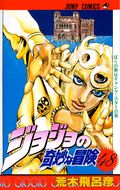
| |
| Volume 49: Find Polpo's Fortune! (ポルポの遺産を狙え! Porupo no Isan o Nerae!) | ||||
|
(JP) September 4, 1996[3] | (JP) ISBN 978-4-08-851899-2 | 
| |
| Volume 50: Operative Bucciarati: The Boss's First Assignment (ブチャラティ幹部:ボスからの第一指令 Bucharati Kanbu: Bosu kara no Daichi Shirei) | ||||
|
(JP) November 1, 1996[4] | (JP) ISBN 978-4-08-851119-1 | 
| |
| Volume 51: The Boss's Second Assignment; Retrieve the Key! (ボスからの第二指令:「鍵をゲットせよ!」 Bosu kara no Daini Shirei: "Kagi o Getto Se Yo!") | ||||
|
(JP) February 4, 1997[5] | (JP) ISBN 978-4-08-851120-7 | 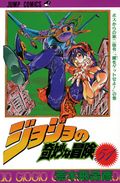
| |
| Volume 52: The Express Train Heading Towards Florence (フィレンツェ行き超特急 Firentse Iki Chōtokkyū) | ||||
|
(JP) April 4, 1997[6] | (JP) ISBN 978-4-08-872039-5 | 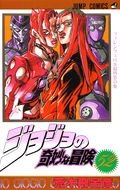
| |
| Volume 53: The Grateful Dead (ザ·グレイトフル·デッド Za Gureitofuru Deddo) | ||||
|
(JP) June 4, 1997[7] | (JP) ISBN 978-4-08-872040-1 | 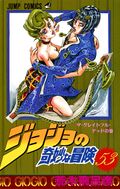
| |
| Volume 54: Gold Experience Retaliates (ゴールド·エクスペリエンスの逆襲 Gōrudo Ekusuperiensu no Gyakushū) | ||||
|
(JP) September 4, 1997[8] | (JP) ISBN 978-4-08-872174-3 | 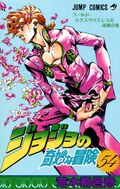
| |
| Volume 55: Battle in Venezia (ヴェネツィア上陸作戦 Venetsia Jōriku Sakusen) | ||||
|
(JP) November 4, 1997[9] | (JP) ISBN 978-4-08-872175-0 | 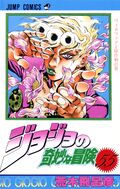
| |
| Volume 56: The G in Guts (ガッツのG Gattsu no "G") | ||||
|
(JP) January 9, 1998[10] | (JP) ISBN 978-4-08-872501-7 | 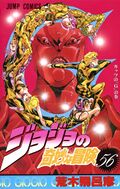
| |
| Volume 57: No Flightcode! Unearth the Boss' Past (フライト·コードなし!ボスの過去をあばけ Furaito Kōdo Nashi! Bosu no Kako o Abake) | ||||
|
(JP) March 4, 1998[11] | (JP) ISBN 978-4-08-872526-0 | 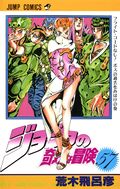
| |
| Volume 58: My Name is Doppio (ぼくの名はドッピオ Boku no Na wa Doppio) | ||||
|
(JP) June 4, 1998[12] | (JP) ISBN 978-4-08-872562-8 | 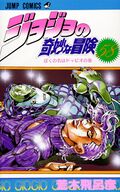
| |
| Volume 59: Like The Falling Sky! (今にも落ちて来そうな空の下で Ima ni mo Ochite Kisō na Sora no Shita de) | ||||
|
(JP) August 4, 1998[13] | (JP) ISBN 978-4-08-872588-8 | 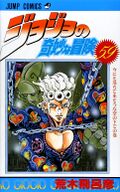
| |
| Volume 60: Meet the Man in the Coliseum! (コロッセオの男に会え! Korosseo no Otoko ni Ae!) | ||||
|
(JP) October 2, 1998[14] | (JP) ISBN 978-4-08-872613-7 | 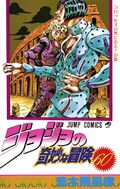
| |
| Volume 61: They Call Him Diavolo (そいつの名はディアボロ Soitsu no Na wa Diaboro) | ||||
|
(JP) January 8, 1999[15] | (JP) ISBN 978-4-08-872652-6 | File:Volume 61.JPG | |
| Volume 62: The Requiem Plays Quietly (鎮魂歌は静かに奏でられる Rekuiemu wa Shizuka ni Kanaderareru) | ||||
|
(JP) March 4, 1999[16] | (JP) ISBN 978-4-08-872680-9 | File:Volume 62.JPG | |
| Volume 63: Sleeping Slaves (眠れる奴隷 Nemureru Dorei) | ||||
|
(JP) April 30, 1999[17] | (JP) ISBN 978-4-08-872709-7 | 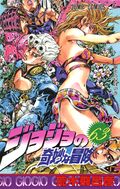
| |
Trivia
- Araki said that he used male idol groups and Italian fashion as the visual inspirations for this part. He wanted to design the main cast in a "pretty boy image" to deliberately contrast the taller, muscular protagonists from previous arcs. Araki remarked that the gay undertones found within certain scenes were included as a homage to the eroticism generally found within the fashion industry. He didn't think that events or character relationships had any deeper meanings behind them until fans brought it to his attention.[1]


